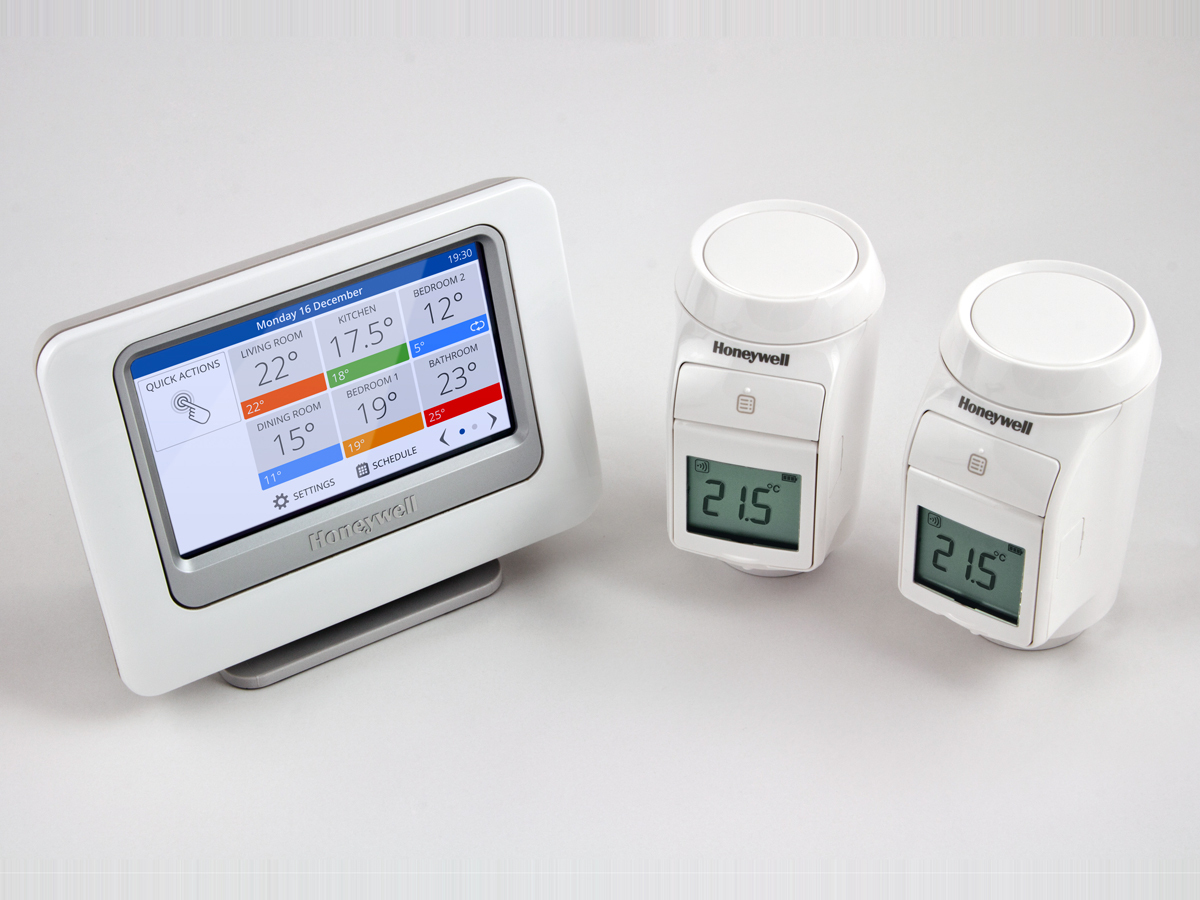The best smart heating systems – reviewed
The age of fiddling with manual timers and thermostats is over: we put five of the most intelligent home heating setups to the test

In case you haven’t noticed, it’s rather nippy outside. And if you’re reading this in the Summer, then let us assure you, it will be cold again. You know, changing seasons and all that.
We’ve come a long way since the humble fire in our fight against Mother Nature’s attempts to render us obsolete, so we’ve gathered a handful of the cleverest heating systems currently on offer, to see how they stack up against each other.
Honeywell EvoHome (£250 plus £70 per radiator plus installation)

Best for family houses
Honeywell’s system is a lot like being God, but without all that business with beards and crosses. You can set schedules to control the precise temperature of each individual room of your home at every moment of the day and night, using either the tablet-like central controller or the free Total Connect Comfort phone app.
You will need special Wi-Fi-connected valves fitted to each radiator you want to control – which soon adds up at £70 a pop – but you can always start with two or three in selected rooms then add more yourself later.
Totally rad
Honeywell’s is the only system in our test that allows you to set different temperatures in different rooms; it uses its own Wi-Fi router.
The smart radiator valves are small enough not to look clunky, and you’re unlikely to be disturbed by the brief whirring noise they make when opening and closing. Each is powered by a pair of AA batteries which, Honeywell claims, should last two or three years depending on how fiddly you make your heating schedules.
The touchscreen controller is a doddle to use, and setting your schedules for the first time is a strangely empowering nerd project. Make the bathroom a couple of degrees warmer at morning shower time… make the kids’ bedrooms a couple of degrees cooler when they’re asleep but you’re still up, thus saving them from sweaty head syndrome… create a weekend schedule with warmer living areas during the daytime, and then engage it on a weekday by selecting ‘day off’ mode. And of course you can save gas by putting the whole house into chilly ‘away’ mode when you go on holiday, then override it from the airport so everything’s back to normal by the time you get home. The valves even learn how long it takes your rooms to heat up and cool down, and will adjust their timings accordingly.
Honeywell reckons EvoHome can knock anything up to 40% off your gas bill by not pumping heat into rooms that aren’t being used (there’s an urban myth that heating up a cold room uses more energy than keeping it warm all day, but that’s cobblers). So, while it is expensive, this system might pay for itself quicker than you think.
Stuff says ★★★★★
A big old investment, but you’ll soon pity anyone living without it
Netatmo (€180)
Best for value for money
The Netatmo by Starck Thermostat For Smartphone, to give it its grandiose full name, is a deceptively simple beast. On the surface, it’s a minimalist perspex box plus a minimalist app, either of which can control your heating with a click.
Delve a little deeper, though, and there are a wealth of customisation options plus some Skynet-level algorithms which, following a two-week learning period, should be able to predict your heating patterns and save you dosh. The physical thermostat can be customised in one of five colours and there are apps for iOS, Android, Windows Phone and web.
Algorithm is a dancer
The Netatmo’s real talent lies in the algorithms that lurk within its electronic brain. The PID algorithm uses data such as how long it takes your house to heat up and what the weather is like outside to fire up the boiler before or after the set time as necessary. You can even link it with the Netatmo Weather Station for ultra-accurate weather info.
Our dating days are long behind us, but living with the Netatmo cast us back to that time when awkward early misunderstandings were followed by heart-thumping love that settled down into comfortable happiness. It’s not the easiest product to install; though Netatmo compares it to changing a lightbulb, that doesn’t generally involve opening your boiler and rewiring mains cables. In the end it only took 20 minutes, but we wouldn’t attempt it hungover.
Once the relay module is hooked up to the boiler, the thermostat links to it via RF and you’re away. Well, almost: the manual neglects to mention the need to connect the relay to your computer first so you can set up the Wi-Fi. That done, you really are away. At which point you fall in love. Looks-wise, the thermostat is a Ferrari in a street full of Fords, and the apps are similarly slick.
You can set multiple heating periods per day, create profiles for different occasions – for instance term-time and holidays – and easily override the schedule: want an hour of 30° toastiness one morning? You got it. It’s a joy to use and does a fine job of making the complex and boring look simple and sexy.
Stuff says ★★★★★
After the tricky first half-hour, it’s an easy system to fall for
Hive (£200 or £150 for British Gas customers, includes installation)

Best for old boilers
Hive plunges your boiler into the connected age, letting you control both your heating and hot water remotely. Your nan will be shocked, your friends will be impressed, and you’ll all be nice and warm.
The British Gas system consists of a thermostat, a hub and a receiver – all controlled by an iOS and Android app, or via a browser. The thermostat lets you see and set temperatures and switch between manual and auto modes, and it talks directly to the hub, which is plugged into a router connecting it to the interwebs. The receiver lets the thermostat control the boiler directly.
Installation is simple and quick – the British Gas installer should be in and out within an hour. Just make sure you’ve got a spare plug socket and free port on your router for the hub to plug into.
The app itself is very slick, and is more attractive than a central heating app has any right to be. Thankfully, it’s easy to use too. Setting up schedules for both the heating and hot water is a breeze, and infinitely better than the archaic setup with (gasp) physical buttons and switches that we had previously.
Tanks very much
Hive has separate controls for hot water tanks. If your home has a ‘combi’ boiler that does both your heating and hot water you won’t need this, but for larger houses with hot water tanks it can be very handy – you might set it to get the hot water stoked up before everyone has their morning shower, for example.
All the systems we tested will kick in if the indoor temperature drops below 5°C, which is handy because it stops your pipes freezing (and exploding).
You’ll find that you hardly have to touch the thermostat thanks to the app, but it’s easy enough to use and lets you adjust the temperature or manually turn on the hot water or heating.
It displays the current room temperature, and requires a button press to see the heating temperature. It would be nice if both were side by side, but that’s just a minor niggle.
If anything, the main problem we’ve faced using Hive is the fact that everyone keeps adjusting the heating to suit their own preferences, opening up a can of Heating War worms. Luckily you can password-protect the app, making you the King of Room Temperature. Status at last…
Stuff says ★★★★★
Great value – Hive’s a winner for those with old-fashioned boilers
Tado (from £200)

Best for small homes
Like Hive, this is a location-based autopilot for your idiot boiler. Tado’s apps (for iOS, Android and Windows Phone) use background geo-fencing to automatically lower or increase your home’s temperature depending on whether you’re off out or coming home. Going for a few unplanned post-work jars? Tado will keep the heating on simmer until it senses that you’re on the bus home with your favourite kebab. The system claims it saves the average person 31% per year on heating bills and pays for itself in under a year.
Tado’s setup is ideal for certain types of people and households. If you’re a social butterfly or work irregular hours, Tado’s location-aware heating is a real time- and money-saver. The most hands-off system around, its polished app is more of a dashboard than an attention-demanding remote control.
Comfort vs cash
Move its ‘comfort level’ bar towards the armchair symbol, and Tado will make sure your home is toasty by the time you step through the door. Go the other way, and it’ll save money by only starting the heating when you get home. You can also select day and night temperatures, and have different preferences for weekdays and duvet-assisted weekends.
Unlike Nest (and like Hive), Tado’s thermostat runs on batteries. This means you can place it on any wall you like, rather than being tied to mains sockets.
Though most self-install the system, there’s also an option of a pro installation. If you don’t already have a thermostat you need to buy the Extension box (£80). From there it’s just a case of attaching the ‘Bridge’ to your router and choosing a spot for the thermostat.
It’s possible to switch to full manual control of the heating, though this is a bit like buying a PS4 just for iPlayer. The system does not encourage manual tweaking, so if your home is witness to regular heating power struggles it might not be for you. But if you like the idea of a heating system that builds and adapts a model of the most efficient way to heat your home, Tado is recommended.
A couple of gripes: the box can lose its connection, sending the system into a dumber ‘Fallback’ mode. And there’s no option of heating individual rooms yet (this is promised for next winter).
Stuff says ★★★★✩
A polished system best suited to small homes and free spirits
Nest Learning Thermostat (£250, with installation)
Best for smart design
Cast your mind back a decade and you may remember having an MP3 player – a clunky, slightly embarrassing device that could, with a bit of fiddling, play digital music.
People would ask you what it was, and you’d explain that it was an MP3 player, and that it was the future. It wasn’t: the iPod was the future, because it was simple and it looked cool. The man who made the iPod, Tony Fadell, has done the same thing to the thermostat.
Nest has a major head start over the others in look and feel: its pleasingly hefty metal dial has an iPod-esque click, and there’s a bright, vibrant display.
Nest Protect
The second product in the Nest line is a smart smoke alarm. It’s pricey but the extra money buys you a few neat tricks. The Protect can trigger a call or email if there’s an alert to tell you what’s wrong – and because it can distinguish between steam, toast-smoke and a real fire, it won’t go off as often as other smoke alarms.
from £90 / nest.com
When you get it working – professional installation takes around 20 minutes, and it’s powered by a standard USB charger – the thermostat is easy to set up and control with a slick, well-designed app offering a digital version of the heating dial, a schedule and settings.
You don’t really have to do anything with the Nest – once you’ve set your optimum temperature a few times, its algorithms quickly create a schedule based on when you get up, get home and go to bed – but it’s more fun to have a tinker. We recommend making use of Nest’s IFTTT (If This Then That) channel. Because it offers map-based geo-fencing, you can have very fine control of when it starts warming the place up (when you’re three bus stops from home, for example), and others can fire up the boiler with a text, email or tweet. There’s even voice control via Google Now.
Once you’ve had your fill of playing around, though, it’s Nest’s sensors and algorithms that give it the edge. It settles into a pattern of getting the temperature right pretty much the whole time, and it’s extremely adept at knowing when you’re away (or in bed) and turning the heating off.
Stuff says ★★★★★
The nicest design, paired with a ton of tricks and features



